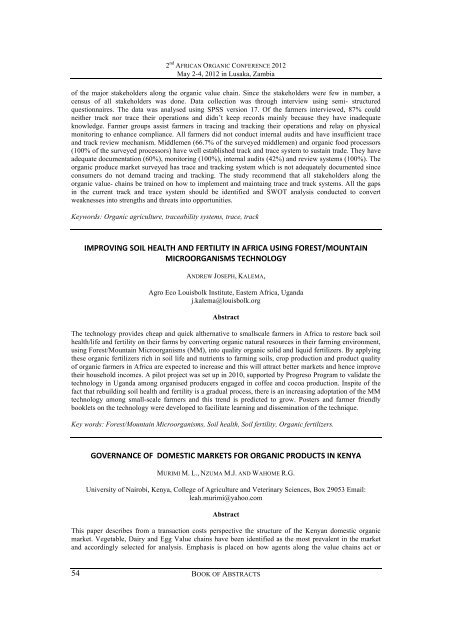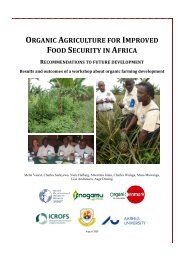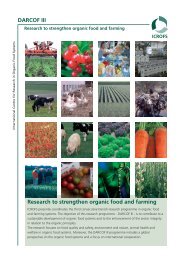The 2nd African Organic Conference â Mainstreaming ... - ICROFS
The 2nd African Organic Conference â Mainstreaming ... - ICROFS
The 2nd African Organic Conference â Mainstreaming ... - ICROFS
You also want an ePaper? Increase the reach of your titles
YUMPU automatically turns print PDFs into web optimized ePapers that Google loves.
2 nd AFRICAN ORGANIC CONFERENCE 2012<br />
May 2-4, 2012 in Lusaka, Zambia<br />
of the major stakeholders along the organic value chain. Since the stakeholders were few in number, a<br />
census of all stakeholders was done. Data collection was through interview using semi- structured<br />
questionnaires. <strong>The</strong> data was analysed using SPSS version 17. Of the farmers interviewed, 87% could<br />
neither track nor trace their operations and didn’t keep records mainly because they have inadequate<br />
knowledge. Farmer groups assist farmers in tracing and tracking their operations and relay on physical<br />
monitoring to enhance compliance. All farmers did not conduct internal audits and have insufficient trace<br />
and track review mechanism. Middlemen (66.7% of the surveyed middlemen) and organic food processors<br />
(100% of the surveyed processors) have well established track and trace system to sustain trade. <strong>The</strong>y have<br />
adequate documentation (60%), monitoring (100%), internal audits (42%) and review systems (100%). <strong>The</strong><br />
organic produce market surveyed has trace and tracking system which is not adequately documented since<br />
consumers do not demand tracing and tracking. <strong>The</strong> study recommend that all stakeholders along the<br />
organic value- chains be trained on how to implement and maintaing trace and track systems. All the gaps<br />
in the current track and trace system should be identified and SWOT analysis conducted to convert<br />
weaknesses into strengths and threats into opportunities.<br />
Keywords: <strong>Organic</strong> agriculture, traceability systems, trace, track<br />
IMPROVING&SOIL&HEALTH&AND&FERTILITY&IN&AFRICA&USING&FOREST/MOUNTAIN&<br />
MICROORGANISMS&TECHNOLOGY&<br />
ANDREW JOSEPH, KALEMA,<br />
Agro Eco Louisbolk Institute, Eastern Africa, Uganda<br />
j.kalema@louisbolk.org<br />
Abstract<br />
<strong>The</strong> technology provides cheap and quick althernative to smallscale farmers in Africa to restore back soil<br />
health/life and fertility on their farms by converting organic natural resources in their farming environment,<br />
using Forest/Mountain Microorganisms (MM), into quality organic solid and liquid fertilizers. By applying<br />
these organic fertilizers rich in soil life and nutrients to farming soils, crop production and product quality<br />
of organic farmers in Africa are expected to increase and this will attract better markets and hence improve<br />
their household incomes. A pilot project was set up in 2010, supported by Progreso Program to validate the<br />
technology in Uganda among organised producers engaged in coffee and cocoa production. Inspite of the<br />
fact that rebuilding soil health and fertility is a gradual process, there is an increasing adoptation of the MM<br />
technology among small-scale farmers and this trend is predicted to grow. Posters and farmer friendly<br />
booklets on the technology were developed to facilitate learning and dissemination of the technique.<br />
Key words: Forest/Mountain Microorganisms, Soil health, Soil fertility, <strong>Organic</strong> fertilizers.<br />
GOVERNANCE&OF&&DOMESTIC&MARKETS&FOR&ORGANIC&PRODUCTS&IN&KENYA&<br />
MURIMI M. L., NZUMA M.J. AND WAHOME R.G.<br />
University of Nairobi, Kenya, College of Agriculture and Veterinary Sciences, Box 29053 Email:<br />
leah.murimi@yahoo.com<br />
Abstract<br />
This paper describes from a transaction costs perspective the structure of the Kenyan domestic organic<br />
market. Vegetable, Dairy and Egg Value chains have been identified as the most prevalent in the market<br />
and accordingly selected for analysis. Emphasis is placed on how agents along the value chains act or<br />
54<br />
BOOK OF ABSTRACTS





